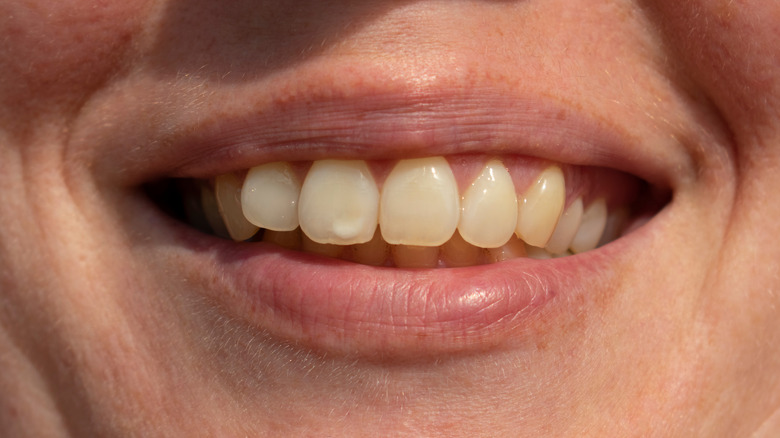What Causes White Spots On Your Teeth?
If you have white spots on your teeth, it can be a warning sign your teeth are going through a process known as decalcification. According to Verywell Health, decalcification is when important minerals on the tooth's surface are removed. Over time, these phosphorus minerals, along with calcium, deteriorate and leave behind discoloration on the teeth in the form of white spots (via Verywell Health). If left untreated, these white spots can lead to cavities, possible tooth loss, and other dental issues.
There are nearly a dozen different factors that put a person at risk of decalcification, Children's Dental Clinic of Green Bay, LLC notes, like poor oral hygiene, braces, and dry mouth. Not brushing your teeth twice a day and skipping flossing puts you at risk of decalcification as bacteria and other debris stay on your teeth for extended periods of time. Additionally, what a person eats and drinks can also increase the threat of decalcification, such as sugary drinks or snacks, carbonated drinks, or drinks with high acid content.
Cause of decalcification
Decalcification is caused by bacteria eating through the tooth's enamel, or the hard, shiny, outer layer of a tooth (via Children's Dental Clinic of Green Bay, LLC). When bacteria, or plaque, is given a chance to build on teeth, the accumulation can be detrimental to your pearly whites. If plaque sits on a tooth's enamel for an extended period of time, the sugar in food and drinks combines with the bacteria in your mouth to form an acid. This acid causes the enamel to weaken and deteriorate, and white spots form in its place (via Children's Dental Clinic of Green Bay, LLC).
While white spots on the teeth are typically permanent, there are treatment options you can try to reverse them. However, there's no guarantee the treatment will work. According to Grand Ridge Orthodontics, 1 treatment option includes putting those important minerals back into the teeth through a process called "remineralization." However, this is usually best for surface treatment, and the enamel may still be discolored at deeper levels. White spots can be prevented through healthy oral hygiene and keeping up with dentist appointments.


